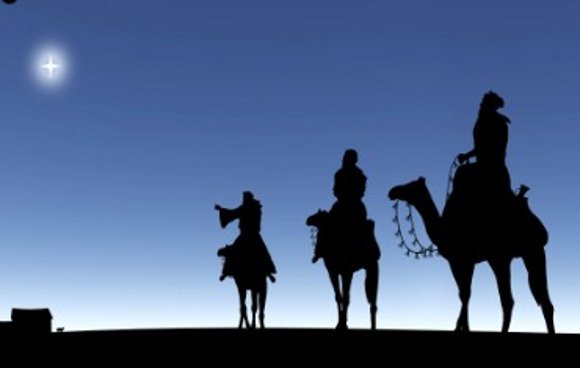Starry Night: What was the Christmas Star? Late December 2011

by Tristan Radtke and Gina Hamilton
To our readers: This annual Christmas Star issue of 'Starry Night' is our special gift to you for the season. Enjoy!
Ah, December ... the loveliest stars of the year begin to emerge after twilight ... the constellations Orion, Gemini, Canis major and minor.
But stars are ubiquitous this time of year, and can be seen in many other places ... decorating houses, treetops and buildings, and in numerous Christmas cards ... and all because of this one brief line from the New Testament:
"Behold, there came three wise men from the east to Jerusalem, saying, Where is he that is born King of the Jews? For we have seen his star in the east, and come to worship him..." - Matthew 2:1-2
What the wise men, or in some translations, the astrologers, may have seen that led them to make a long journey to welcome a new king has been open to debate over the years (including whether it was not just fanciful storytelling on the part of the writer of the Book of Matthew), but most astronomers agree that the "star" was probably not, in fact, a star. Stars were well-known objects, appeared regularly on an annual basis, and no new permanent stars had appeared in human history.
Other historical information (such as the death of King Herod and the timing of the census that sent Joseph and Mary to Bethlehem) in the New Testament and elsewhere suggests a period of time between 7 B.C.E. and 4 B.C.E. for the actual birth of Jesus of Nazareth. What was visible in the sky during that period that might have led the astrologers to travel? Here are some of the possible "suspects" for the Bethlehem "star":
• A meteor or particularly bright fireball?
Probably not. Meteors and fireballs were not that uncommon in an evening sky without light pollution, and lasted only seconds at the most. The astrologers watched the "star" for many months as they traveled.
• A comet?
While Halley's comet made visit in 11 B.C.E., no record of particularly bright comets was made during the period believed to be most likely, even by the astronomically inclined Chinese. Even if there had been one, comets were usually seen as harbingers of doom, not joyful heralds of a new birth.
• A supernova?
While a supernova, or even a bright recurring nova, would have been enough to attract the attention of dedicated skywatchers, there was apparently no such object during the probable period.
So what was the Christmas star?
Most astronomers believe that it was a conjunction of planets, possibly the triple conjunction of Saturn and Jupiter in the constellation Pisces, which was the constellation associated with the Jews (and later, the Christians). This took place over several months in 7 B.C.E., its most striking conjunction occurring in the fall of that year.
In the fall of 7 B.C.E., the two planets moved so closely together that they appeared to be a single bright object, shining in the autumn sky. Since Saturn was considered the protector of Judea, and Jupiter connoted royalty, the astute Magi of Babylon may have concluded that this sign was a sign of the birth of a king in Judea who would protect that nation.
A more recent conjunction, of Venus and Jupiter in the winter of 1999, was an amazing sight, and it is easy to see how such a bright conjunction could inspire wonder, hope, and faith.
Whether the Christmas star was a conjunction of planets, an appearance of a planet in a favorable constellation ... or something more ... it has become part of the Christmas mythology, and tradition, and is an interesting addition to the holiday season.
** The Planets **
- Mercury: Mercury begins mid-December rising at about 5:30 a.m., and by year’s end it will be just about to reappear from the Sun’s glare but still lost within it around sunrise.
- Venus: Easily the most visible planet in the month of December, Venus starts mid-month setting at around 6 p.m., and by January 1 it will set at about 6:30 p.m.
- Mars: Mars rose in tandem with the Moon on December 15, around 10:40 p.m. By January 1, Mars will rise at about 10 p.m.
- Jupiter: Jupiter set at 2 a.m. on December 15, and by January 1 it will set around 1:15 a.m.
- Saturn: Saturn continues to shadow Jupiter, rising at 2 a.m. on December 15, and at about 1:15 a.m. on January 1.
- Uranus: Uranus will set at about 11:15 p.m. on December 15, and by January 1 it will set at 10:30 p.m.
- Neptune: Neptune remains incredibly dim and hard to spot this month, but on December 15 it set around 9 p.m., and by the end of the month it will set around 8 p.m.
- Pluto: Pluto moved into the Sun’s glare on December 15, setting right around sunset, and by January 1, Pluto will be deep within the glare of the Sun, reappearing after the New Year.
** The Moon **
The Moon will reach third quarter waning on December 18, and new phase on December 23. It will begin to wax into the New Year, reaching first quarter on New Year’s Day.
**Special Events**
Today marks the Winter Solstice, which occurred at 12:30 a.m.


